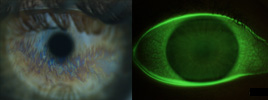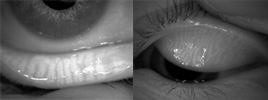The integrity and stability of tear film are critical to maintain a high quality of vision and good ocular comfort. Dry eye(1) and tear film disorders are the most common multifactorial ocular diseases present in 14-33% of the adult population(2). Dry eye physiologically increases with age, particularly in women and in patients with diseases such as diabetes, rheumatoid arthritis and autoimmune diseases.
It is claimed that 20-50%(3) of contact lens wearers complain ocular dryness. These patients experience occasional or chronic adverse symptoms such as: soreness, grittiness, scratchiness and burning eye. These symptoms can reduce contact lens’ wearing time and cause drop out which is supposed to afflict the 12-51%(4) of contact lens wearers.
The tear film is the first refractive surface of the eye with a thickness from 4 to 9 µm. With EASYTEAR® VIEW+ is easily visualize in vivo the interference fringes of the lipid layer in tear film. The color changes with the thickness of Lipid layer from 30 to 180 nm.
1. Definition and Classification of Dry Eye. Report of the Diagnosis and Classification Subcommittee of the Dry Eye WorkShop (DEWS). Ocul Surf 2007;5:75-92.
2. Schaumberg, D.A., Sullivan, D.A., Buring, J.E., Dana, M.R.. Prevalence of dry eye syndrome among US women. Am. J. Ophthalmol. 2003 136, 318–326.
3. Doughty MJ, Fonn D, Richter D, Simpson T, Caffery B, Gordon K. A patient questionnaire approach to estimating the prevalence of dry eye symptoms in patients presenting to optometric practices across Canada. Optom Vis Sci 1997;74:624-31)
4. Dumbleton K, Woods CA, Jones LW, Fonn D. The impact of contemporary contact lenses on contact lens discontinuation. Eye Contact Lens. 2013;39:92–98.
5. Papagni A; Fonte R; Benzoni L; Pre-lens tear film evaluation scale: a tool for analyzing the tear film-lens interaction with respect to the material used; Optometry Reports. 2012;1: 31-36


